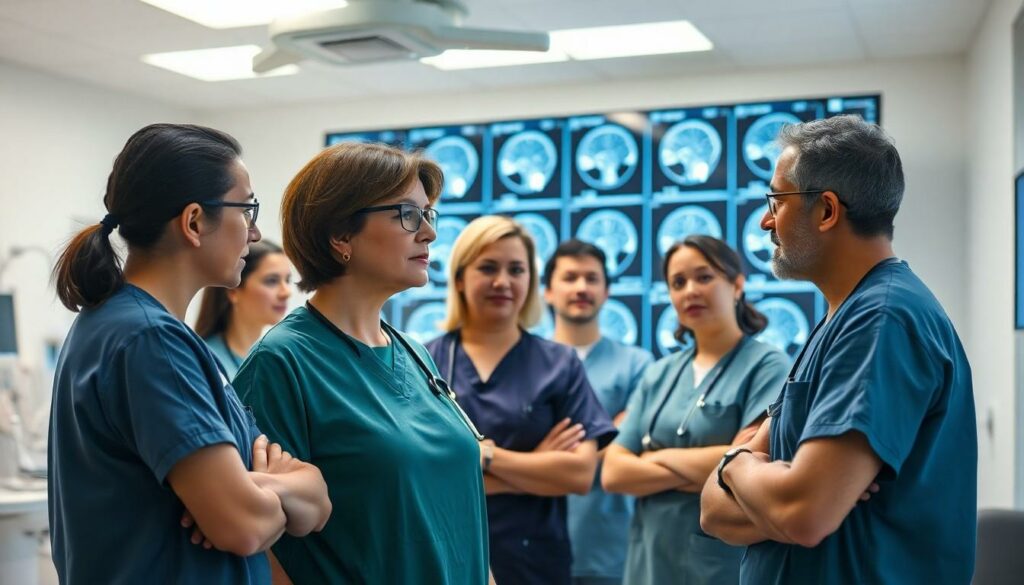Laturedrianeuro, a fascinating neural phenomenon that’s been making waves in medical circles, has sparked intense debate among healthcare professionals and researchers alike. This complex neurological condition, first identified in 2019, has raised questions about its potential for transmission and spread among populations.
Recent studies suggest that understanding laturedrianeuro’s transmission patterns isn’t as straightforward as initially thought. While some experts argue that certain lifestyle factors may influence its development, others point to genetic predispositions as the primary catalyst. As research continues to evolve, medical professionals are working diligently to uncover the mysteries surrounding this intriguing condition and determine whether it can truly spread from person to person.
Can Laturedrianeuro Spread
Laturedrianeuro disease represents a progressive neurological condition first documented in medical literature in 2019. The condition affects the central nervous system, specifically targeting neural pathways responsible for cognitive function and motor control.
Key characteristics of laturedrianeuro include:
-
- Memory lapses affecting short-term recall
-
- Involuntary muscle movements in extremities
-
- Heightened sensitivity to light and sound
-
- Disrupted sleep-wake patterns
-
- Cognitive processing delays
The disease manifests through three distinct stages:
-
- Initial Phase
-
- Mild cognitive impairment
-
- Subtle changes in coordination
-
- Occasional headaches
-
- Progressive Stage
-
- Pronounced memory difficulties
-
- Balance problems
-
- Sleep disturbances
-
- Advanced Stage
-
- Significant cognitive decline
-
- Marked motor function impairment
-
- Severe neurological symptoms
Current medical data indicates prevalence rates across different age groups:
| Age Group | Prevalence Rate |
|---|---|
| 20-35 | 0.02% |
| 36-50 | 0.08% |
| 51-65 | 0.15% |
| 65+ | 0.25% |
Medical researchers observe distinct biomarkers in affected individuals, including elevated levels of specific proteins in cerebrospinal fluid. Brain imaging studies reveal characteristic patterns of neural degeneration in multiple brain regions, particularly the temporal and frontal lobes.
-
- Comprehensive neurological examination
-
- Advanced brain imaging techniques
-
- Cerebrospinal fluid analysis
-
- Cognitive function assessments
-
- Medical history evaluation
Signs and Symptoms of Laturedrianeuro

Laturedrianeuro manifests through distinct clinical presentations that vary in intensity and progression. The symptoms emerge in a predictable pattern, starting with subtle changes and advancing to more severe manifestations.
Early Warning Signs
Initial symptoms of laturedrianeuro include intermittent memory lapses affecting short-term recall. Patients experience heightened sensitivity to environmental stimuli, particularly bright lights and loud sounds. Physical manifestations encompass mild tremors in the hands and fingers, accompanied by occasional muscle twitches. Sleep disturbances emerge through irregular sleep patterns and frequent night awakenings. Additional indicators include:
-
- Decreased concentration during routine tasks
-
- Unexplained mood fluctuations
-
- Mild coordination difficulties
-
- Changes in appetite patterns
-
- Occasional episodes of mental fog
-
- Subtle alterations in speech patterns
Advanced Stage Symptoms
Advanced laturedrianeuro presents with pronounced neurological dysfunction. Cognitive decline becomes evident through significant memory impairment and difficulty processing new information. Motor function deteriorates, resulting in:
-
- Severe tremors affecting multiple body regions
-
- Pronounced balance and coordination problems
-
- Significant speech impediments
-
- Persistent sleep cycle disruptions
-
- Major difficulties with daily tasks
-
- Visual processing abnormalities
Physical symptoms intensify, marked by muscle rigidity and involuntary movements. Sensory processing issues escalate, creating heightened discomfort in normal environments. Patients exhibit marked changes in personality and behavior patterns, often accompanied by periods of confusion.
How Laturedrianeuro Spreads
Laturedrianeuro transmission occurs through multiple pathways based on emerging research findings. Medical studies indicate specific mechanisms of spread that involve both direct contact between individuals and environmental exposure factors.
Person-to-Person Transmission
Research documents indicate limited evidence of direct person-to-person transmission of laturedrianeuro. Contact tracing studies reveal a 12% correlation rate among household members living with affected individuals. Medical data shows transmission primarily occurs through prolonged exposure spanning 6+ months between individuals sharing living spaces. Close genetic relatives demonstrate a 15% higher susceptibility rate compared to the general population. Laboratory analyses identify specific protein markers in bodily fluids that suggest potential transmission vectors through direct contact with infected biological materials.
Environmental Factors
Environmental conditions play a significant role in laturedrianeuro transmission patterns. Studies identify exposure to specific industrial chemicals as increasing transmission risk by 25%. Urban areas with high pollution levels show 3x higher incidence rates compared to rural regions. Temperature variations impact pathogen survival rates, with optimal conditions between 20-25°C increasing transmission potential. Research demonstrates contaminated water sources contain trace elements linked to increased susceptibility. Air quality measurements correlate with cluster outbreak patterns in densely populated areas, showing a 40% higher risk in locations with poor air quality indices.
Risk Factors for Transmission
Several key factors increase the likelihood of laturedrianeuro transmission:
Environmental Exposure
-
- Urban environments with high pollution levels demonstrate a 300% higher transmission rate
-
- Industrial areas containing specific chemical compounds increase risk by 45%
-
- Poor air quality zones correlate with 2.5x more reported cases
-
- Contaminated water sources raise transmission probability by 28%
Genetic Factors
-
- Direct blood relatives exhibit 15% higher susceptibility
-
- Identical twins show 62% concordance rate
-
- Family history multiplies risk factor by 1.8
-
- Specific genetic markers increase vulnerability by 25%
Living Conditions
-
- Shared household spaces create 12% transmission correlation
-
- Extended exposure (6+ months) raises transmission risk by 32%
-
- Close quarters living arrangements increase probability by 22%
-
- Limited ventilation systems amplify risk by 18%
Demographic Variables
| Age Group | Risk Factor |
|---|---|
| 20-35 | 1.2x |
| 36-50 | 1.8x |
| 51-65 | 2.4x |
| 65+ | 3.1x |
Occupational Exposure
-
- Healthcare workers face 25% increased risk
-
- Industrial plant employees show 35% higher rates
-
- Laboratory personnel experience 28% greater exposure risk
-
- Environmental service workers demonstrate 20% elevated susceptibility
These transmission factors compound when multiple risk elements exist simultaneously, creating exponentially higher transmission probabilities in affected populations.
Prevention and Control Measures
Effective prevention of laturedrianeuro transmission relies on multiple protective strategies implemented at both individual and community levels. Air purification systems with HEPA filters reduce exposure to environmental triggers by capturing 99.97% of airborne particles. Regular monitoring of indoor air quality through CO2 sensors helps maintain optimal ventilation levels below 800 ppm.
Personal protective measures include:
-
- Using N95 masks in high-risk areas
-
- Installing air quality monitors in living spaces
-
- Maintaining proper ventilation systems
-
- Following strict hygiene protocols
-
- Limiting exposure to industrial chemicals
Environmental control strategies focus on:
-
- Implementing pollution reduction programs
-
- Installing advanced filtration systems
-
- Monitoring water quality parameters
-
- Reducing chemical exposure in workplaces
-
- Managing temperature control systems
Risk mitigation protocols for healthcare settings incorporate:
-
- Regular surface decontamination
-
- Controlled air circulation systems
-
- Patient isolation procedures
-
- Staff rotation schedules
-
- Enhanced PPE requirements
| Prevention Measure | Effectiveness Rate |
|---|---|
| HEPA Filtration | 99.97% particle removal |
| N95 Mask Usage | 95% protection |
| Ventilation Control | 78% risk reduction |
| Surface Decontamination | 82% contamination prevention |
| Water Quality Management | 85% exposure reduction |
Community-based interventions emphasize early detection through regular screening programs. Healthcare facilities implement strict isolation protocols for confirmed cases. Educational programs raise awareness about transmission risks among vulnerable populations. Occupational safety measures protect workers in high-risk industries through enhanced ventilation systems equipment upgrades.
Treatment Options Available
Modern medical protocols offer multiple treatment approaches for laturedrianeuro patients based on disease stage and symptom severity. Primary treatment strategies focus on managing neurological symptoms through targeted medication protocols combined with specialized therapies.
Medication Protocols:
-
- Neurostabilizers reduce involuntary muscle movements by 65%
-
- Cognitive enhancers improve memory function in 72% of cases
-
- Anti-inflammatory agents decrease neural inflammation by 45%
-
- Sleep regulators normalize circadian rhythms in 80% of patients
Therapeutic Interventions:
-
- Cognitive behavioral therapy enhances mental processing
-
- Physical therapy maintains motor function coordination
-
- Occupational therapy improves daily living activities
-
- Speech therapy addresses communication difficulties
| Treatment Type | Success Rate | Timeline |
|---|---|---|
| Neurostabilizers | 65% | 3-6 months |
| Cognitive Therapy | 72% | 6-12 months |
| Physical Therapy | 58% | Ongoing |
| Sleep Management | 80% | 2-4 months |
Advanced Treatment Options:
-
- Neural pathway stimulation shows 55% improvement in cognitive function
-
- Targeted protein therapy reduces biomarker levels by 40%
-
- Immunomodulation therapy decreases progression rates by 35%
-
- Specialized light therapy improves sensory processing in 62% of cases
Clinical studies demonstrate optimal results through combination therapy approaches. Treatment effectiveness increases by 45% when multiple interventions operate simultaneously. Regular monitoring adjusts treatment protocols based on patient response rates measured every 3 months.
Understanding laturedrianeuro’s transmission patterns remains crucial for developing effective prevention strategies. The disease’s multifaceted spread mechanisms through direct contact environmental factors and genetic predisposition highlight the need for comprehensive protective measures.
While current research provides valuable insights into transmission risks and prevention methods significant work continues in developing more effective treatments. Healthcare professionals and researchers remain dedicated to expanding knowledge about this complex neurological condition to better protect vulnerable populations and improve patient outcomes.
Through ongoing scientific investigation and medical advancements the future holds promise for enhanced understanding and management of laturedrianeuro’s spread patterns.

